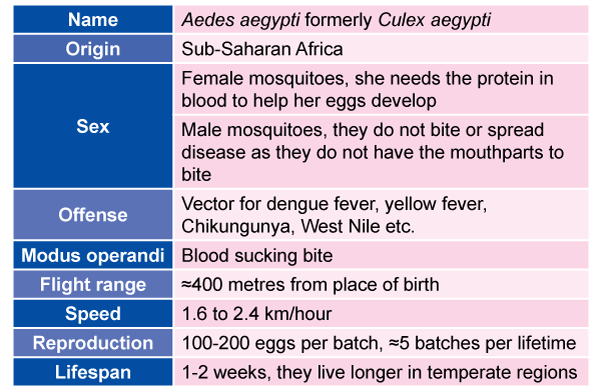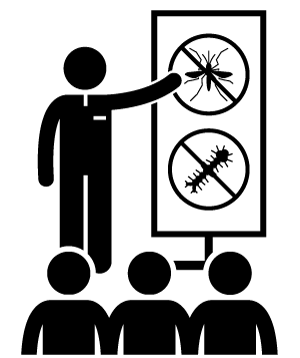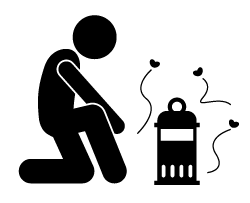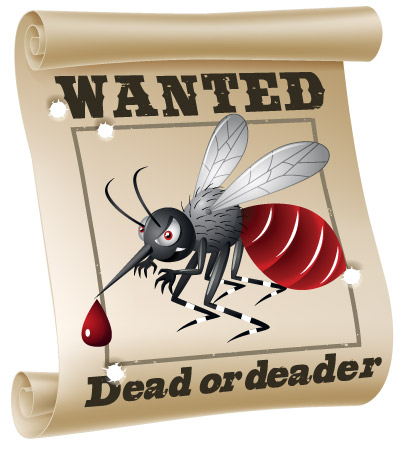Every year, 390 million dengue infections are recorded, of which 96 million manifest clinically. More than 70% of the global disease burden is in Asia, specifically the Western Pacific Region. Malaysia ranks first among countries in the Western Pacific in terms of the number of reported dengue cases.
Dengue is transmitted by the bite of a female Aedes aegypti mosquito infected with any one of four serotypes of the dengue virus.
Public Enemy #1, Aedes!

Our Arsenal
Various control methods have been used over the years to help curb the spike in dengue cases nationwide, as underlined through the nation’s Strategic Plan for the Control and Prevention of Dengue. These include:
- Larviciding
- Fogging
- Enforcement of law
- Public education and awareness campaigns

Despite all this, dengue cases continue to rise. This has prompted the exploration of new and innovative control methods/technologies, some of which are:
1. Genetically modified sterile mosquitoes
The male Aedes aegypti (OX513A) mosquito strain developed by the Institute for Medical Research (IMR), Malaysia and Oxitec has a selflimiting genetic element. When female Aedes aegypti mate with the OX513A male mosquitoes, any offspring will die, hence preventing the emergence of the next generation of adult mosquitoes. The released sterile male itself will also die. The first open release trial was conducted at an uninhabited area in Bentong, Pahang in 2010 but nationwide implementation is still pending. This has apparently been deemed too expensive for nationwide implementation.

2. Mosquito repellent paint
Kansai Coatings Malaysia Sdn Bhd launched a mosquito repelling paint in 2014, said to be the first in ASEAN countries. The water-based paint they developed uses synthetic insecticides to repel mosquitoes.
More recently, IMR announced that it too had developed an anti-mosquito wall paint. The paint, mixed with the insecticide deltamethrin, would not only repel but also kill mosquitoes that come into contact with walls coated with it. IMR is currently looking for interested manufacturers to help produce it.

3. Mosquito Repellent App
KIL-DENGUE is an app that was introduced in July this year by the company New Wave Communications Sdn Bhd who developed the software alongside IMR. The app uses specific sound waves to repel the Aedes mosquito and tests have demonstrated the app to be up to 75% efficacious. You can download the app at Google Play or Apple App Store for about RM10. The technology of using sound waves to deter mosquitoes is not new and the science behind it is anything but comprehensive. However, many consumers worldwide who use sound wave repellent technology say they work just fine.

4. Mosquito traps
One of the latest industrial inventions in mosquito traps involve the use of human-mimicking attractants such as odour, light, CO2, heat and even sound. Made for both large-scale and household use, these devices lure, trap and kill mosquitoes with varying degree of effectiveness. Various simple home made mosquito traps were discussed in our last issue Vol.3). In exploring different dengue vector control options in high-risk residential areas, local authorities in Pulau Pinang, Selangor and Putrajaya have embarked on a pilot project to test the effectiveness, impact and viability of this new technology.

5. Dengue vaccine
Sanofi Pasteur completed their final landmark phase III efficacy study of its dengue vaccine candidate successfully. Results showed a 95% efficacy against dengue haemorrhagic fever, 80.3% reduction in the risk of hospitalization and an overall significant reduction of 60.8% of dengue disease cases in children and adolescents 9-16 years old after a three-dose vaccination schedule given 6 months apart. The vaccine may be available in Malaysia sometime late next year.

Though these new methods are promising, we shouldn’t abandon our self-reliant actions against dengue. Continue doing your part to help keep your family and the community safe by:
1. Ensuring that there are no mosquito breeding grounds in your area
-
- Discard unwanted containers that can hold water
- Ensure that water tanks and containers are covered with lids
- Ensure that flowerpot plates and water catchment
containers are drained at least once a week
- Ensure that roof gutters are constantly flowing
2. Taking steps to protect your family from bites:
- Install window mesh/screen.
- Apply mosquito repellent cream on skin when going outside
- Wear brightly coloured clothing with long sleeves and pants while outdoors
- Use mosquito coils, spray and electric mosquito repellent when necessary
- Avoid outdoor activities when Aedes mosquitoes are most active (i.e. 5.30-8.30 am and 5.30-8.00 pm)
An educational contribution by Malaysian Paediatric Association






Comments